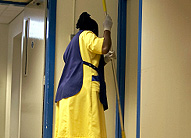Ancillary Health Care Work
Ask Canadians “Who provides health care?” and they are most likely to mention doctors and nurses. Whether the issue is training, shortages, recruitment, retention, salaries or conditions of work, the discussion usually focuses on these health care professions. Doctors and nurses are of course highly valued and their work is the most visible work in the health care system. But the health care system could not function, and people would not receive the care they need and deserve, without the vital contributions from Ancillary Workers, whose work is so often hidden from policy discussions.
This so-called ancillary work seems to be hidden because it takes
place behind the scenes, but also because it is taken for granted.
Tasks that involve the daily restoration of order — garbage removal,
floor cleaning, changing beds, food preparation, dish washing, record-keeping
— are often only noticed when they do NOT occur. We become conscious
of them in their absence, when the normal routine is disrupted.

Much of this hidden health care work is performed by women, doing jobs that have historically been defined as “women’s work”. These jobs often resemble women’s traditional work in the home. As such, they are commonly undervalued and assumed to require very little skill. This means that workers and services defined as ‘ancillary’ can be more easily turned over to private, for-profit companies, while ‘real’ health care work is protected from such forms of privatization.
Women and Health Care Reform investigated the working conditions
and changes in policy for ancillary workers, to demonstrate that
this important women’s work is essential to our universal health
care system, and to illustrate how changes and health care reforms
are critical women’s issues in health. 
